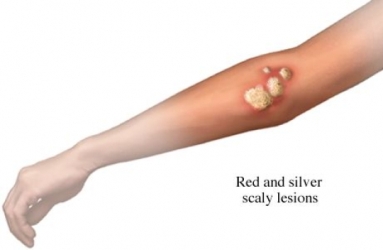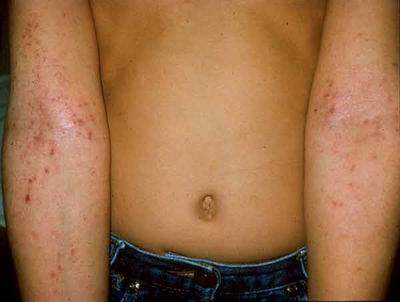Atopic Dermatitis Information
Click here to scroll to the list of available medications ↓
Atopic dermatitis is a chronic skin disease, often referred to as eczema. Atopic dermatitis causes chronic irritation, swelling, and itching of the skin and commonly affects children or young adolescents. Atopic dermatitis can affect adults as well, although over 85% of adults who have it received their first outbreak of the condition in childhood. Atopic dermatitis is not contagious, nor does it represent a health risk with the exception of being uncomfortable.
The most common symptoms of atopic dermatitis include red, swollen, itchy, inflamed skin that can crack, peel, weep, crust, or scale. These symptoms generally start off as a mild skin rash that leads to a severe skin rash. Atopic dermatitis can attack any part of the body, including the face.
There are numerous causes of atopic dermatitis, and studies show that emotional stress plays a large role in how well a patient avoids a serious outbreak after being exposed to one of their risk factors. Direct contact atopic dermatitis comes from the direct contact with an allergen. The allergen is specific to the patient and can lead to a serious break out. Common allergens include meats, nickel, rubber, jewelry, weeds, perfumes, cosmetics, and a very common ingredient found in topical antibiotic creams known as neomycin.

Atopic dermatitis is considered a genetic disease, one that families with hay fever and other allergies on conjunction with easily irritated skin can develop early. It is thought that one significant cause of atopic dermatitis includes an immune system that is hyper sensitive and over reacts to an allergen.
Diagnosing atopic dermatitis isn’t as simple as running a test. There is no definitive test that will rule out other skin conditions, nor is there any set symptoms that point directly to atopic dermatitis. Rather, the patient will present with unique symptoms all of their own and it may take several outbreaks and several visits to the physician before an accurate diagnosis can be made. Medical history and family history can be vital in determining the patient has atopic dermatitis faster than without, as this condition tends to run in families with hay fever. A family history of allergic diseases, and detailed account of the activities, foods, and other influential factors just before a flare up can also help with a diagnosis.

It is not uncommon for people with skin reactions to be referred to an allergist for further testing. An allergist will test the skin against common and not so common irritants, usually on the back, with a grid of allergy solutions. Tiny scratches are made on the skin with a needle soaked in the allergen solution. Given ten or fifteen minutes, the skin will swell and itch in the grids where the allergen solutions were scratched only if the patient is allergic to the solution. This test can be very helpful in diagnosis skin allergies as well as narrowing down the possibilities that can cause the skin’s irritation. Narrowing down the possible causes for the skin irritation as well as ruling out other skin conditions can lead to an accurate diagnosis.
Complications from atopic dermatitis are fairly mild, including impetigo, as skin infection caused by the bacteria staphylococci. Itching leads to scratching which also leads to infections as the skin tears. Other complications which may set in from having atopic dermatitis include the development of small papules on the skin, a condition known as Lichenification which means the browning and leathering of the skin from repeated infections, Ichthyosis, which is the development of rectangular shaped scales, an extra fold or pleat under the eye which is called atopic pleats, the darkening of the skin under and around the eye which is called hyperpigmented eyelids, and cheilitis, which is inflammation of the skin surrounding the lips.
For mild to moderate cases of atopic dermatitis, the physician is likely to prescribe a topical cream that helps to ease the symptoms caused by the irritation. In more severe cases or if the skin cracks open, the physician may prescribe wet dressings and astringents in order to prevent the skin from opening and secreting fluids and to help prevent infection. Antihistamines may be prescribed to alleviate the itching and immunomodulators may help regulate the immune system and create a more normal skin texture. Treatments such as Elidel and Protopic are recommended only when other treatment options have failed or when the patient is intolerant to other forms of treatment.
Living with atopic dermatitis is not easy, as outbreaks can be embarrassing as well as uncomfortable. Patients should be instructed to avoid scratching as much as possible, avoid known irritants, and to wear light, comfortable clothing as often as possible to help prevent or worsen any future outbreaks of atopic dermatitis.